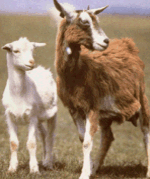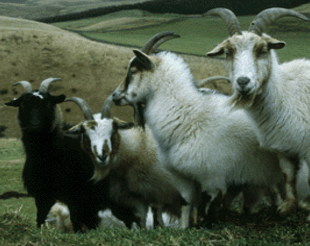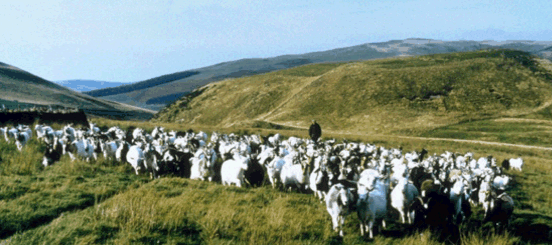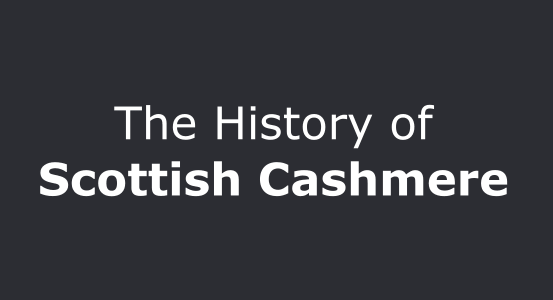In response to demand from the UK textile industry, a cashmere fibre producing industry is being established in Scotland by a dedicated group of farmers.
Scottish reared goats are producing Scottish cashmere to enhance the quality of the finest of Scottish knitwear and accessories.
It all began in 1985 when, as a result of initial research in Scotland, several farmers recognised the benefits of integrating cashmere-producing goats into their existing farm management systems.
With support from Government Research Establishments, the Textile Industry, Scottish Enterprise, Highlands and Islands Enterprise and the European Commission, these innovative farmers established the Scottish Cashmere Producers Association.
The role of the Scottish Cashmere Producers Association (SCPA) is to:
- encourage the selection of superior breeding stock.
- provide advice and assistance to new cashmere goat farmers.
- act as a forum for cashmere producers and users, and a spokesman for cashmere farmers.
- provide a central marketing operation for the collection, grading, processing and marketing of cashmere fibre and its products.
Compared to world production, Scottish cashmere farmers are producing tiny amounts of fibre.
The next challenge is to build up the national herd to at least 10,000 goats, and to develop a sustainable industry in control of its own future.
The ultimate cashmere fibre
 As one of the world’s most rare and valuable fibres, cashmere is prized by the textile and knitwear industries for its softness and handle.
As one of the world’s most rare and valuable fibres, cashmere is prized by the textile and knitwear industries for its softness and handle.
The raw product is the fine downy undercoat of goats, grown during the winter months under the coarse, outer, weather-resistant guard hair.
During the longer, warmer days of spring, the down is shed from the coat and is harvested by combing or shearing.
The United Kingdom – and particularly Scotland, famed for its skills in producing high quality knitwear – is the world’s largest processor of cashmere fibre and has traditionally imported cashmere from China, Mongolia, Iran and Afghanistan.
Related reading: Where does cashmere originally come from?
Now, however, cashmere is being grown by Scottish cashmere goats.
Farmed predominantly in Scotland, these goats produce high quality cashmere, which is processed into a unique range of products – both grown and manufactured in Scotland.
Today over 50 cashmere farmers with around 2,500 goats are demonstrating that cashmere fibre production is an exciting option for Scottish agriculture, especially in the economically fragile ‘less-favoured areas’.
Scottish Cashmere Goat
The goat is no stranger to the hill and upland farms of Scotland.
 During the 18th and 19th centuries farmed herds were common all over the country.
During the 18th and 19th centuries farmed herds were common all over the country.
Major changes in social structure and agriculture lead to their decline and their potential remained forgotten until recently.
Now, with their unique grazing habits, goats are recognised for their role in the management of sown and indigenous pastures.
With the production of valuable cashmere, goats have the potential to make a significant contribution to existing farm systems.
Scottish cashmere goats are not difficult to manage.
Improved by selective breeding and crossing with cashmere goats from around the world, the Scottish cashmere goat is based on the hardy Scottish feral, and remains hardy and adaptable.
The goats are easily controlled and herds are managed in a similar way to flocks of sheep.
The main difference lies in harvesting the fibre.
The growth of the coat is seasonal and the cashmere moults in early spring.
This allows it to be combed from the goat in the traditional way, but it may also be harvested by shearing.
Popularity of Scottish Cashmere
Today Scotland’s cashmere farmers are producing cashmere fibre of the quality demanded by the textile industry and comparable to the finest imported fibre.
The Scottish cashmere goat was developed in Scotland from hardy feral goats which have roamed the hills and uplands for hundreds of years and are still found in parts of Galloway, the Borders, the Highlands and the Western Isles.

These goats have been improved by careful cross-breeding with goats from Iceland, Siberia, New Zealand, and Tasmania.fgyu
Each exotic breed has contributed its own special qualities, which when combined, give Scottish cashmere its unique identity.
Participants in the fledgling industry joined together, forming the Scottish Cashmere Producers Association, which takes the raw fibre through to the finished product.
With the specialised knowledge and skills of Scottish processors and spinners, Scottish cashmere is processed into a luxurious and exclusive range of 100% pure Scottish cashmere knitwear and accessories. Special packaging and our distinctive logo ensure that Scottish cashmere retains it’s exclusive identity.
Further reading: Johnstons Cashmere – A Scottish Tradition Based on a Chinese Goat
Scottish cashmere is capturing the imagination of buyers world-wide.
Cashmere from the far northern isles of Orkney and Shetland, through the majestic Highlands to the gentle rolling hills of the Borders is now being sold in elegant department stores from Tokyo to Milan.


Good morning!
Could you please connect me to cashmere yarn producing companies? I am looking to import some to the USA
Cheers,
Rebecca Welsh
Hello
SCOTTISH CASHMERE PRODUCERS ASSOCIATION ceased trading on 31st December 2017.
Does that mean that there is no longer anyone breeding cashmere goats or producing cashmere in Scotland anymore ?
Thanks if you you have any information.
Hello
The SCOTTISH CASHMERE PRODUCERS ASSOCIATION looks like ceased trading on 31st December 2017.
Does that mean that there is no longer anyone breeding cashmere goats or producing cashmere in Scotland anymore ?
Thanks if you you have any information.
Try Myreside Farm, Inverkeilor, Angus – hello@myresidefarmsproduce.co.uk
Cashmere Goat flock.
Are the Scottish goats which Scottish and Edinburgh Cashmere treated well and painlessly
Import cashmere come from abuse goats like Mongolia and China. So before I buy I want to know if Scottish goats are treat and shearing cruel free way. Thank You
@sharka, please get the full facts before making a statement that is largely incorrect. I have been in the cashmere industry for over 35 years, over 20 years in Scotland and for the last 10 years based in Mongolia. I have visited hundreds of nomads herders over the last 10 years and I’ve never seen any cruelty to the animls, on the contrary, the goats are very well looked after. I’m happy to discuss this further dugscott@hotmail.co.uk
Dear Dug, do you know any high quality cashmere fabric producers based in Scotland?
There is no such thing as animal welfare in China and alpacas at least are tied down and have there wool or hair ripped out so expect the goats receive the same torture. Would be nice to think if you were purchasing a garment made in Scotland, all the wool was produced in Scotland also. Hopefully making it cruelty free.